Mark Caney's Blog, page 33
September 21, 2013
September 11, 2013
Dolphin-Assisted Therapy Discussed in The Lancet
Kimmela Center executive director Dr. Lori Marino is quoted extensively in an article about animal-assisted therapies by Adrian Burton in the prestigious medical journal The Lancet Neurology.
The article, entitled “Dolphins, dogs, and robot seals for the treatment of neurological disease” asks:
“A growing body of evidence suggests that animal-assisted therapies and activities involving all kinds of real and even robotic animals can have beneficial effects in people with neurological disease or mental illness. But what is the quality of that evidence, and do these interventions really provide any health benefits?”
Burton notes that while there are numerous reports of animal-assisted activities and therapies being beneficial to people with neurological or mental disorders, this growing field lacks “high-quality evidence regarding the value of such therapies.”
Dolphin-assisted therapy is an especially lucrative activity that’s offered by facilities all over the world, making claims, among others, that swimming and interacting with dolphins increases attention span, motivation, motor function, and language skills in severely disabled children, and provides similar therapeutic benefits for those with autism, epilepsy, Angelman’s syndrome, dyslexia, or Tourette’s syndrome.
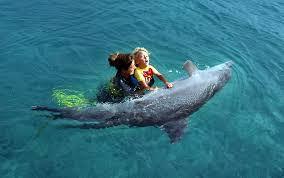 But how good is the science behind these claims? Dr. Marino says most of it is of very low quality:
But how good is the science behind these claims? Dr. Marino says most of it is of very low quality:
“Many reports in the literature are observational or, when prospective, involve very small numbers of patients or lack critical control conditions. As a result, most suffer from problems with construct validity—i.e., the inability to identify which components of the study (being in a pool, human interactions, new settings, etc.) are causally related to any observed short-term changes.
“… Most studies are plagued by major threats to construct validity such as placebo effects, novelty effects, demand characteristics, experimenter expectancy effects, [and] informant bias,” she says. “If it cannot be determined that the dolphin is an important therapeutic ingredient then there is no basis for most of the claims made by the lucrative industry that has grown up around dolphin-assisted therapy.”
Read full story: Kimmela Center

September 10, 2013
Fascinating, Rare Dolphins and Whales You’ve Never Seen Before
Sometimes, it seems, large whales and talking dolphins get all the attention. Yes, we love these animals, too – how can you not? A humpback whale launching itself from the sea like a giant, blubbery rocket and crashing down with a triumphant spray of seafoam can impress even the most curmudgeonly of whale watchers.
But the pantheon of cetaceans includes far more than just our charismatic, coastal kin. Preferring deeper water and diving for more than an hour at a time, some species of whales and dolphins are rarely seen, and seldom studied. These animals slip stealthily between the waves at the surface and retreat into a deep blue world that we still know very little about.
It takes a determined observer to learn the patterns of a pod of dwarf sperm whales, for example, and predict where they’ll surface next.
Robin Baird, a biologist at the Cascadia Research Collective, has spent years doing just this, in the waters around the Hawaiian Islands. He once lived on Maui, but now visits the islands several times a year, looking for the region’s rarest and most elusive whales and dolphins. Rising straight out of deep ocean water, the Hawaiian Islands offer easy access to the realm of deep-diving creatures. Baird’s work, part of which is funded by the U.S. Navy, is providing unprecedented insights into the animals’ social structures, the risks introduced by human activities in the region, and how the different species share the waters around the islands.
By now, Baird and his colleagues have probably logged more hours studying these unusual species than any other crew on the planet. They recently published a study summarizing 1,758 sightings between 2000 and 2012. Among other observations, the work included a calculation of how frequently a species is seen in the region: Average sightings per 100 hours on the water. Some whales, like humpbacks, will be seen hundreds of times in a 100 hours. Others, like false killer whales, come in at 0.64 — or, almost never.
Baird’s mission? “We work with every species we encounter,” he says. “But we spend the most time with the species we encounter the least often.”
Full story: Wired

September 7, 2013
Blackfish – the movie
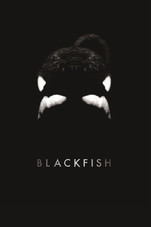 I just watched Gabriela Cowperthwait’s excellent documentary: Blackfish. The film explores the problems that have occurred when Orcas are kept in captivity, and how accidents are bound to happen when these magnificent animals’ frustrations are eventually vented and “trainers” are tragically hurt or killed. It’s hard to see how anyone can justify keeping cetaceans in concrete tanks after seeing this film.
I just watched Gabriela Cowperthwait’s excellent documentary: Blackfish. The film explores the problems that have occurred when Orcas are kept in captivity, and how accidents are bound to happen when these magnificent animals’ frustrations are eventually vented and “trainers” are tragically hurt or killed. It’s hard to see how anyone can justify keeping cetaceans in concrete tanks after seeing this film.
If you can’t see the movie in your local cinema you can buy or rent it on iTunes.
Mark Caney

September 3, 2013
Win a copy of Dolphin Way – entrance is free
Goodreads Book Giveaway

Dolphin Way
by Mark Caney
Giveaway ends October 31, 2013.
See the giveaway details
at Goodreads.
Watch a two minute trailer for the book:

Dolphin photo wins British Wildlife Photography award
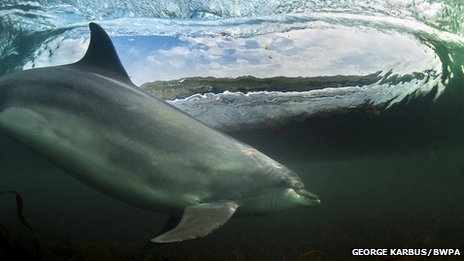 An underwater photo of a bottlenose dolphin surfing a wave at Ballintoy, County Antrim has won the top prize at the 2013 British Wildlife Photography Awards.
An underwater photo of a bottlenose dolphin surfing a wave at Ballintoy, County Antrim has won the top prize at the 2013 British Wildlife Photography Awards.
The winning photo, called In the Living Room, was taken by photographer George Karbusa, a professional free diver originally from the Czech Republic, who now lives in Ireland.
George described the experience of watching a surfing dolphin as “one of the most incredible sights you can see in the ocean”.
“This photograph was taken in the most intimidating and surf-heavy spot on the north coast of Ireland, called Ballintoy,” he said.
“I encountered this playful dolphin that suddenly started to surf the deep tube inside the waves.
“Each time he got into the wave, I dived underneath the water, held my breath and waited for the moment when he would swish through a silver barrel close enough to my lens.
“Water visibility is always very limited in Ireland, and I was very lucky to get a shot like this.”
George’s winning image will be exhibited as part of an exhibition at the Mall Galleries, London from 2 September, before the it tours the UK.
The image can also be seen in a book featuring images from the awards to be published later in September.
The British Wildlife Photography Awards were established to recognise the talents of wildlife photographers working in Britain and highlight the diversity of Britain’s natural history and the need for its protection.
Source: BBC

August 31, 2013
US Navy testing will “kill hundreds of dolphins and whales”
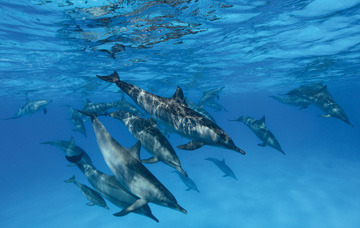 The US Navy admits its underwater training and experiments will result in the deaths of hundreds of dolphins and whales over the next five years – but insists that its testing program is essential.
The US Navy admits its underwater training and experiments will result in the deaths of hundreds of dolphins and whales over the next five years – but insists that its testing program is essential.
Computer models showed that the Navy will likely kill 186 whales and dolphins off the East Coast and 155 near the coast of Hawaii and Southern California – its main operation areas – between 2014 and 2019.
Results also showed that marine mammals on both coasts would likely suffer more than 13 thousand serious injuries and nearly 4 million minor ones.
Most of these will be the result of underwater explosions, though some injuries will be the result of physical contact with ships, or sonar testing. Larger species are particularly vulnerable to Navy activities.
The Navy is obliged to annually commission these studies – which take existing data about the impact of military activities on marine wildlife, and project it into the future – due to federal environmental regulations. If it injured animals without having done the impact study, it would risk seeing its off-shore activities suspended altogether, as it would be a violation of federal environmental law.
Rear Adm. Kevin Slates, the energy and environmental readiness division director for the Navy, defended the planned operations, regardless of the figures.
“Without this realistic testing and training, our sailors can’t develop or maintain the critical skills they need or ensure the new technologies can be operated effectively,” he told the media earlier this week.
The influential non-profit National Resources Defense Council (NRDC) has said that the studies show that the Navy’s open-sea program is “simply not sustainable”.
Michael Jasny, senior policy analyst at NRDC, says that the real impact is greater still than what the Navy has projected.
The Navy studies show that there will be almost 28 million “minor instances” of behavior change that will occur as a result of the testing. But Jasny believes that these temporary disturbances – such as a dolphin that is not able to use a feeding ground, or a whale that is scared and starts panicking – can also prove to be fatal.
“These smaller disruptions short of death are themselves accumulating into something like death for species and death for populations,” Jasny said.
Source: RT

August 26, 2013
Dolphin in River Dee in Flintshire, UK rescued by RNLI
A dolphin has been rescued after swimming miles up the River Dee in Flintshire four days ago.
The grey and white mammal became stuck on sandbanks on Thursday at Saltney Ferry, near Chester.
An RNLI lifeboat hoisted the dolphin out of the water before carrying it out to sea, according to the British Divers Marine Life Rescue.
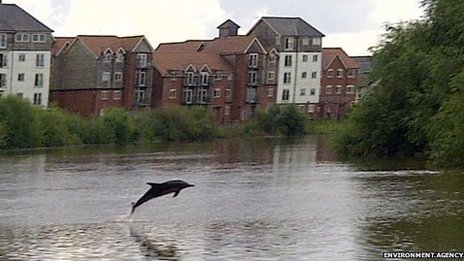 The dolphin, in the river since Monday, will be taken three miles off the coast of Rhyl.
The dolphin, in the river since Monday, will be taken three miles off the coast of Rhyl.
Alan Forrester, lifeboat operations manager with Flint RNLI, told Radio Wales the rescue boat was launched at Connah’s Quay after the dolphin was seen “floundering” on a sandbank.
It was hoisted onto the lifeboat and carried down the river towards open water.
An animal welfare officer is also onboard.
“We’ve got what we call an ambulance pouch, which is a rolled up stretcher,” Mr Forrester added.
“They laid that on the sandbank and rolled the dolphin into the stretcher and lifted it into the lifeboat.
“It’s rather a large dolphin. It’s lying there nicely, they’ve got buckets of water to keep it cool – everything seems to be ok at the moment.”
The mammal was originally spotted by the public on Monday in Connah’s Quay docks and became stranded briefly on Tuesday after turning to make its way to Flint and towards the sea.
Liverpool coastguard wanted to hold off a rescue attempt for as long as possible to avoid coming into physical contact with the mammal in case it is rejected back at sea.
A coastguard team was earlier deployed to the area to try to ensure the safety of spectators trying to catch a glimpse of the dolphin.
It is thought the dolphin swam up the river during the high spring tide.
It is rare for dolphins to be seen in the River Dee but a pair of porpoises were reported near Queensferry Bridge eight years ago.
Full story with video: BBC

August 24, 2013
Why don’t dolphins fight back?
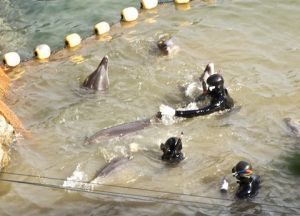 Many people are now familiar with the scene that is playing out in the photo to the right. It was taken in Taiji, Japan, a place where hunting and killing dolphins is commonplace. However, this particular photo captures a moment in time that bears closer scrutiny. It presents us with compelling questions about dolphin emotional intelligence and their relationships with humans, and it challenges us to rethink the way we treat these beings of the sea.
Many people are now familiar with the scene that is playing out in the photo to the right. It was taken in Taiji, Japan, a place where hunting and killing dolphins is commonplace. However, this particular photo captures a moment in time that bears closer scrutiny. It presents us with compelling questions about dolphin emotional intelligence and their relationships with humans, and it challenges us to rethink the way we treat these beings of the sea.
Take a closer look at the photo. It captures the last few moments of these dolphin’s lives, as the divers you can see in the water guide them to their deaths. These dolphins are going – unwillingly, yet relatively peacefully – beneath a tarpaulin-covered area where they will be restrained by their tails beside one another.
A metal spike will then be driven slowly into their heads. To watch this process, see below (warning: graphic content is distressing). Their family and friends are thrashing about in the water all around them, utterly exhausted and likely terrified after the hours-long chase that brought them into the fishermen’s nets. If you look closely at the photo, you can see that some of the dolphins are already bleeding, the result of hurling themselves upon the rocks in an attempt to escape the fishermen and the horrors that are occurring beneath the tarpaulin.
The dolphins in this photo have been backed into a corner, with fishermen and certain death on one side, and the net separating them from freedom on the other. What species of wild animal do we know of – or even who among our own – would not lash out when backed into such a corner?
Yet, like the thousands of dolphins before them, these dolphins will not attack. And not for lack of ability – weighing in at around 800 pounds, armed with sharp teeth and powerful tails, these top predators could do some serious damage to those humans in the water. But they refrain, time and again. This undeserved benevolence towards humans is baffling, at best. However, scientific investigations of the dolphin brain appear to offer some insight to this complaisant behavior.
Our brains share many structural similarities with dolphins. For example, we both have a limbic system, which is responsible for handling emotional information. One difference between us, however, is that the dolphins’ limbic system is much larger than ours and, says scientist Denise Herzig, it “may be stretched out over more of the brain,” indicating that “the dolphin brain may have more of a ‘global connection’ to [emotional] information”. This could mean that dolphins are more emotional than humans, and that emotions could figure more prominently throughout their thought processes.
While it might be tempting to think that increased emotions would lead to greater aggression when being backed into a corner, another compelling feature of the dolphin brain appears to account for this notion. Sterling Bunnell, in The Evolution of Cetacean Intelligence points out that the cerebral cortex, responsible for logical thought and reasoning in both humans and dolphins alike, is controlled by the emotional activity of the limbic system. This process is facilitated by what are called ‘neocortical association neurons’.
Bunnell observed that, in human studies, the ratio of these neurons to limbic-system brain stem neurons “is necessary for such qualities as …emotional self-control” and that a decreased ratio is associated with “impulsiveness, emotional instability, irritability, loss of humor”. Bunnell points out that dolphins possess a higher neocortical-limbic ratio than the average human, suggesting that their control over their own emotions is greater than what we experience.
It could be that dolphins, while being more emotional, are more emotionally stable than we are, and are therefore able to better control themselves in stressful situations. This could explain their apparent control over the impulse to lash out at the humans who are so callously ending their lives.
Read full story: Ecologist

August 14, 2013
Dolphin die-off hitting Virginia hardest
 A dolphin die-off in the Mid-Atlantic region is hitting Virginia, USA hardest.
A dolphin die-off in the Mid-Atlantic region is hitting Virginia, USA hardest.
Nearly 50 dolphins were found dead or dying in Virginia in July — seven times the normal rate for that month — and the pace is picking up.
“August is looking to be significantly worse,” said Mark Swingle, director of research and conservation for the Virginia Aquarium & Marine Science Center in Virginia Beach.
The nonprofit aquarium is home to Virginia’s sole program for responding to stranded dolphins, whales and sea turtles.
Bottlenose dolphins, intelligent and charismatic mammals loved by the public, are dying at abnormally high rates this summer from New York to Virginia — 156 animals from July 1 through Monday. The average for a full year in that region is 99.
Most of the dolphins washed up dead. Some died soon after being found or were so near death they had to be euthanized. None has survived to be returned to the wild.
Full story: Times Dispatch






